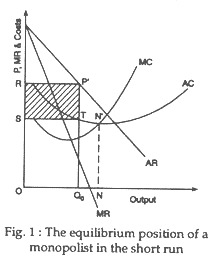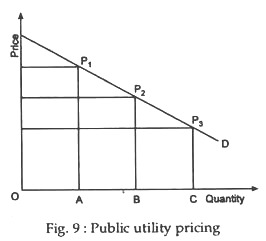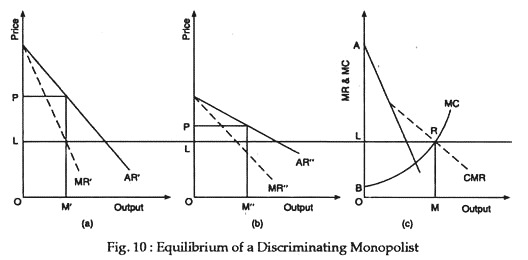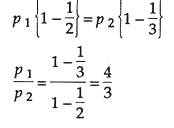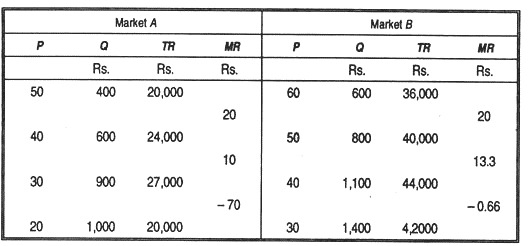‘Discriminating monopoly’ or ‘price discrimination’ occurs when a monopolist charges the same buyer different prices for the different units of a commodity, even though these units are in fact homogeneous. Such a situation is described as “perfectly discriminating monopoly”. It is more usual, however, to find that a monopolist sells identical products to different buyers at different prices.
Discrimination between buyers is more usual than discrimination between units of a homogeneous commodity. In general, it can be said that price discrimination occurs when a producer sells a commodity to different buyers at two or more different prices for reasons not associated with differences in costs. It may be either systematic (i.e., discrimination systematically and persistently) or unsystematic (i.e., discrimination frequently or casually).
In the simplest case, there is one identical good going to two buyers (or groups of buyers).
Then:
ADVERTISEMENTS:
Price of buyer 1/Cost ≠ Price of buyer 2/Cost
For example, buyer 1 might be retail purchasers of a medical drug (low elasticity of demand), while buyer 2 is a group of large hospitals (high elasticity). Cost might be Re 1 per bottle.
The ratios might then be:
Rs10/Re1 ≠ Rs 2/Re 1 so that P1/P2 = 5
ADVERTISEMENTS:
That is fairly steep discrimination. Actual discrimination is usually milder, but it can go even steeper if the conditions are right. The firm gets profits from both parts of the market, but one part is much more attractive than the other. Consumers pay partly by their ability to pay, rather than by cost levels.
Degrees of Discrimination:
Price discrimination is of various types: Here we draw a distinction among three types of price discrimination.
First Degree:
ADVERTISEMENTS:
The limit is defined in the concept of discrimination of the first degree, a concept introduced by A.C. Pigou. In discrimination of the first degree, the monopolist knows the maximum amount of money each consumer will pay for any quantity. He then fixes up prices accordingly and takes from each consumer the entire amount of his consumer’s surplus.
This type of situation occurs when the monopolist sells each unit of his product at a different price. This means that he changes the maximum price a consumer is ready to pay for each unit, i.e., as much as the traffic will bear. This type of situation is illustrated in Fig.1. Mrs. Joan Robinson calls this phenomenon perfect discrimination, which is perfect, however, only from the point of view of the monopolist.
The simplest kind of discrimination of the first degree is one where, for some reason, each of his customers buy only one unit from the monopolist. When consumers buy more than one unit of the monopolist’s product, they are willing to buy more units at lower prices. The monopolist must then adjust his units of sale.
This kind of discrimination is the limiting, or extreme, case. Obviously, it could occur only rarely where a monopolist has only a few buyers.
Second Degree:
In discrimination of the second degree, the monopolist captures parts of his buyers’, consumers’, surplus, but not all. This is frequently found in public utility pricing. The different of rates charged by public utilities like the CESC is an obvious example. Fig. 9 illustrates this point.
If the demand curve of any customer is known, the public utility can divide that demand curve into small segments, so that, in effect, it becomes many customers. For each segment, from the highest portion of the demand curve to the lowest, the utility can charge a different price, one which reflects the willingness of the customer to buy a given amount, of say, electricity at that price.
ADVERTISEMENTS:
Second degree price discrimination “is necessarily practised in markets where there are many buyers, sometimes hundreds of thousands of them.” One rate or price schedule must apply to all buyers. Because tastes and incomes differ, the monopolist can seize only a small part of the consumers’ surpluses of those buyers whose desires for his service are stronger, and whose incomes are higher. Second degree discrimination is furthermore limited to services sold in blocks of small units — cubic feet of gas, kilowatt hours of electricity, minutes of telephoning — that can be easily metered, recorded and billed.
Third Degree:
Allocation of a Given Amount. Third degree price discrimination refers to the fact that the monopolist divides his customers into two or more classes or groups, charging a different price to each class of customer. Each class is a separate market, e.g., the D.C. seats in a cinema halls, the reserved seats in a cultural programme and so on.
This is the commonest kind of price discrimination. Here, the monopolist sells the same commodity in two separate markets at two separate prices at the same time. Thus, he applies the equi-marginal principle: the last unit sold in each of the two markets makes the same addition to total revenue. Third-degree discrimination is that situation where in each of several markets there is a separate demand function.
ADVERTISEMENTS:
Equilibrium Conditions of a Discriminating Monopoly:
A discriminating monopolist, like an ordinary monopolist, tries to get maximum profits. He would supply the product in different amounts to achieve his ultimate goal. In fact, his action of price discrimination is profitable if the elasticity of demand in one market is different from the elasticity of demand in the other.
If the elasticity of demand for the product of the monopolist is greater in market A than what it is in market B, the monopolist would gain by reducing the supply in market B and thereby increasing the supply in market A. If a discriminating monopolist is to be in equilibrium, two separate conditions have to be fulfilled.
(1) Marginal revenue in both (or all) markets must be the same:
ADVERTISEMENTS:
When the elasticity of demand for a monopolist’s product is different in different markets, he would supply a smaller amount and charge a high price for the product where the demand is inelastic; but he would supply a larger amount and charge a low price for the same where the demand is elastic. By doing so, he will have to equalise the marginal revenue in both or all markets.
(2) The marginal revenue derived from each of these markets must also equal the marginal cost of the monopolist’s total output:
It means that the monopolist would supply the different amounts in A and B markets in such a way and up to that amount at which the marginal revenue from the sale in each of these markets must be equal to the monopolist’s marginal cost of producing the total output (aggregate of output in A and B).
In other words, the equilibrium condition of a discriminating monopolist becomes:
MR1 (marginal revenue in market A) = MR2 (marginal revenue in market B) = MC.
These two conditions are nothing more than an application of the general principle of equilibrium, i.e., MR = MC.
ADVERTISEMENTS:
The equilibrium under discriminating monopoly can be shown in the following figure.
In Fig. 10(a) and (b) show the average and marginal revenue curves of the firm for two separate markets (sub-market A and sub-market B). These markets have different elasticities of demand at each price. In Fig.10 (c) the profit maximising output (OM) is shown at the intersection of the marginal cost curve (MC) for the monopolist’s whole output, with the curve showing combined marginal revenue (CMR) obtained from the two markets. The curve CMR is obtained by adding the curves MR1 and MR2 together sideways.
In this equilibrium situation, the output is OM, and marginal revenue is OL or MR. The output OM has, therefore, to be distributed between the two separate markets in such a way that marginal revenue in each is OL. It means that OM’ is to be sold in sub-market A at price OP (marginal revenue is here OL).
Similarly, OM” must be sold in sub-market B at a price of OP” (marginal revenue here is also OL). The monopolist’s profit is shown by the area ARB in Fig. 10(c) and here it is at a maximum.
Output under Price Discrimination:
ADVERTISEMENTS:
The total output of a monopolist with two or more prices can be either larger or smaller than his total output if he would sell at one price. Conceivably, too, a monopolist could have an output equal to the output corresponding to conditions of pure competition.
In practice, demand and cost relations can be such that without discrimination a particular commodity or service will not be produced at all. Take the case of India’s sugar industry. If free sale of sugar is prohibited production of sugar will be unprofitable.
Some commodities and services might not be produced at all if sellers were not be able or were not allowed to practice price discrimination. The standard and simple example is the physician in a small village. Similarly, railroad service on a particular route might depend on the ability of the railroad to charge higher rates to some groups of commuters than to others.
Preconditions of Price Discrimination:
It is obvious that discrimination between buyers is not possible under perfect competition because of the existence of a large number of sellers selling an identical product. It can only occur when there is a monopoly. But even under monopoly it is not always possible. A.C. Pigou has mentioned two important conditions for the successful operations of price discrimination by a monopolist.
1. No Possibility of Resale of Product:
ADVERTISEMENTS:
A monopolist succeeds in price- discrimination where the products, mainly the services, cannot be resold or when the resale of the product or leakage of the product from low-priced to high-priced market can be prevented. A doctor having a monopoly position in a particular locality can charge rich patients high fee but poor patients low fee, for his services rendered.
Here, he becomes successful because his services cannot be resold. Similarly, lawyers and business consultants sometimes charge rates for their services that vary according to the incomes of their clients. Direct personal services like teaching, legal advice, haircut, modelling, etc., which cannot be resold by the buyers, foster price discrimination.
A commodity cannot be resold when it fulfills two important conditions:
(a) Units of its demand cannot be transferred from high-priced to low-priced markets, and
(b) Units of its supply cannot be transferred from low-priced to high-priced markets.
In other words, arbitrage (transfer of the commodity from low-priced to high-priced market) can be stopped somehow.
ADVERTISEMENTS:
2. Separation of Markets:
Price discrimination is also possible when markets are separated from one another. Geographically or politically markets cannot meet one another for the re-buying or the re-selling of the products. Dumping is an outstanding example of this type of discriminating monopoly.
Besides these two conditions, price discrimination is also possible under the following conditions:
(a) A monopolist becomes successful in price discrimination on account of consumers’ peculiarities; such as consumers’ ignorance about the prices, consumers’ irrational feeling about the quality of the product, consumers’ indifference towards small price differences, etc.
(b) Again, a monopolist becomes successful in price discrimination when the demand for his product has different elasticities in two sub-markets or different markets. He can sell his product at high prices in one market where its demand is inelastic (e.g., woolen dresses at cold places) but at low prices in the other sub-markets where its demand is elastic (e.g., woolen dresses at warm places).
It will pay the monopolist to transfer units of output from one market to other markets when the elasticity in two markets is different. In fact, the price discrimination will be profitable only when elasticity of demand in one market (or sub-market) is different from that in the other.
(c) When there is no state intervention or legal bar, a monopolist can successfully practise price discrimination.
(d) Finally, price discrimination is also possible when buyers and sellers are separated from one another by a great distance.
These conditions can also be extended to cover the case where a firm is a monopolist in one market but is operating under conditions of perfect competition in another. In this case, the marginal cost of producing the whole output must equal the price prevailing in the perfect market.
The part of the output, which is sold in the monopolised market, must be so restricted as to equalise the marginal revenue in that market to the marginal cost of the whole output. The price in the latter market will be higher than the price prevailing in the perfect market. This consequence follows from the fact that in the perfect market the average revenue curve of the firm is a horizontal straight line while in the other market it is downward sloping.
The relationship between marginal revenue and price is given by the formula mr = p (1 – 1/e).
Using the symbols indicated earlier we get the following equations:
Marginal Revenue in market A = p1 {1 – 1/e1}
Marginal Revenue in market B = p2 {1 – 1/e2}
It has been shown that when the monopolist is earning maximum net revenue, the marginal revenues in the two markets must be equal.
Therefore, at equilibrium:
P1 {1 – 1/e1} = p2 {1 – 1/e2}
In this equation if e1=e2 then p1=p2. Therefore, it follows that when the demand-elastics (in the different markets, at the relevant output levels) are equal, the monopolist will charge the same price in the different markets. If the demand-elastics are different markets. If the demand elasticities are different, price-discrimination is profitable, and therefore possible.
The relationship between the price in the two markets (p1: p2) can be calculated from the equation given above. In general, the price will be higher in the market where the elasticity of demand is lower.
The analysis of price discrimination, given above, can be easily extended to the case of more than two markets.
Example 1:
Suppose that elasticity in market A is equal to 2 and elasticity in market B is equal to 3. Then,
If in market A, Price is p1 = Rs. 4, then in market B, price is p2 = Rs. 3.
Example:
A monopolist has two markets and the demand schedules in them are as follows:
He wants to sell 1,400 units. What price will he set in the two markets and why?
Solution:
A discriminating monopolist reaches equilibrium and hence maximises profit when he equates the marginal revenue(s) in-both the markets, i.e., MR1 = MR2. If this condition holds total revenue will be maximum and revenue maximisation subject to cost constraint implies profit maximisation. So, we may calculate total revenue from each market for different price-quantity combinations and then the corresponding MR.
So, when the firm sells 600 units in market I, at a price of Rs. 40 per unit and 800 units in market 2 at a price of Rs. 50, MR1 = MR2 and total revenue is Rs. 24,000 + Rs. 40,000 = Rs. 64,000 which is maximum. No other combination of Q1 and Q2 will yield the same total revenue and hence raise profit further.
